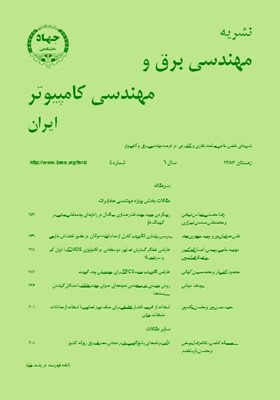رويکردی جديد جهت فشردهسازی سيگنال در رادارهای چندحاملی مبتنی بر کدينگ فاز
محورهای موضوعی : مهندسی برق و کامپیوتررضا محسنی 1 , عباس شیخی 2 , محمدعلی مسندی شیرازی 3
1 - دانشگاه شیراز
2 - دانشگاه شیراز
3 - دانشگاه شیراز
کلید واژه: رادارهای چندحاملیسيگنالهای MCPCرادارهای OFDMفشردهسازیتخمين کانال,
چکیده مقاله :
از جمله سيگنالهايی که اخيراً جهت دستيابی به حد تفکيک بالا در رادار ارائه شده است، سيگنالهای چندحاملی مدولهشده فاز (MCPC) ميباشند. روش متداول برای فشردهسازی اين سيگنالها همانند رادارهای مدولهشده فاز تکحاملی، مبتنی بر استفاده از فيلتر منطبق يا محاسبه مستقيم تابع همبستگی ميباشد. در اين مقاله روشی جديد مبتنی بر FFT بهمنظور فشردهسازی اين سيگنالها ارائه گرديده که بار محاسباتی آن بهمراتب کمتر از روش مرسوم ميباشد. همچنين بر پايه ديدگاه ناشی از اين روش، ساختاری جهت تخمين کانال مخابراتی ارائه ميشود که ميتوان از اين تخمين جهت بهبود کيفيت آشکارسازی و تخمين موقعيت اهداف تحت ردگيری بهره جست.
Multicarrier phase coded signals have been recently introduced to achieve high range resolution in radar systems. As single carrier phase coded radars, the common method for compression of these signals, is using matched filter or computing the auto correlation function directly. In this paper we propose a new method based on fast Fourier transform (FFT) with lower computational load with respect to traditional approach. Furthermore, based on this new approach, a method for estimation of communication channel is introduced that can be used for improving detection performance and target position estimation in tracking mode.
[1]M. Jankiraman, B. J. Wessels, and P. V. Genderen, "Design of a multifrequency FMCW radar," in Proc. of 28th European Microwave Conf., vol. 1, pp. 584-589, Amsterdam, Oct. 1998.
[2]N. Levenon, "Multifrequency radar signals," in Proc. of IEEE Int. Radar Conf., pp. 683-688, May 2000.
[3]N. Levenon, "Multifrequency complementary phase-coded radar signal," IEE Proc. Radar, Sonar Navig., vol. 147, no. 6, pp. 276-284, Dec. 2000.
[4]E. Mozeson and N. Levenon, "Multicarrier radar signals with low peak - to - mean envelope ratio," in IEE Proc. Radar, Sonar Navig., vol. 150, no. 2, pp. 71-77, Apr. 2003.
[5]N. Levenon and E. Mozeson, "Multicarrier radar signal-pulse train and CW," IEEE Trans. AES, vol. 38, no. 2, pp. 707-720, Apr. 2002.
[6]N. Levenon, "Train of diverse multifrequency radar pulses," in Proc. ofIEEE Radar Conf., pp. 93-98, May 2001.
[7]N. N. S. S. R. K. Prasad, V. Shameem, U. B. Desai, and S. N. Merchant, "Improvement in target detection performance of pulse coded Doppler radar based on multicarrier modulation with fast Fourier transform (FFT)," in IEE Proc. Radar Sonar Navig. , vol.151, no. 1, pp. 11-17, Feb. 2004.
[8]S. P. Singh and K. S. Rao, "Pulse train of multicarrier complementary phase coded radar signal for favourableautocorrelation and ambiguity function," in Proc.Int. Conf. on Systemics, Cybernetics, and Informatics, ICSCI 2005, pp. 76-80, Jan. 2005.
[9]G. E. A. Franken, H. Nikookar, and P. Van Gendern," Doppler tolerance of OFDM-coded radar signals," in Proc. of the 3rd European Radar Conf., pp. 108-111, Sep. 2006.
[10]N. Levenon and E. Mozeson, Radar Signals, John Wiley & Sons, Inc., New York, 2004.
[11]A. V. Oppenheim and R. W. Schafer, Discrete Time Signal Processing, Prentice Hall, 1999.

